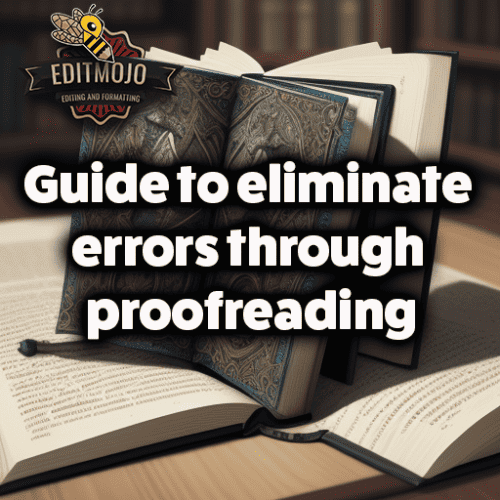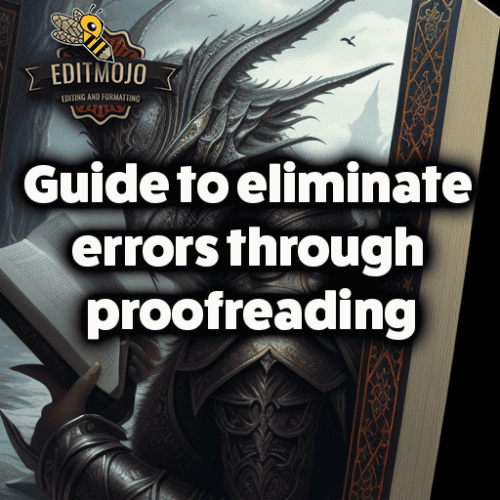Guide to eliminate errors through proofreading
Guide to eliminate errors through proofreading. The written word is a powerful tool, one that can inspire, educate, and move people. But with great power comes great responsibility, including the necessity of perfecting that tool. That’s where proofreading comes into play. This process, often overlooked, plays a crucial role in ensuring the clarity and accuracy of our written communications.
Errors—be they grammatical, syntactical, punctuation, or formatting-related—can severely affect readability and professionalism. They can be the difference between making a compelling argument or losing your audience entirely. This guide aims to help you tackle these mistakes head-on and emerge as a more confident and proficient writer.
Key Takeaways
| Topic | Key Points |
|---|---|
| Importance of Proofreading | Enhances readability and professionalism, increases credibility, improves reader engagement |
| Common Errors | Includes grammatical, punctuation, spelling, typographical, stylistic, and formatting errors |
| Proofreading Techniques | Focused reading, fresh eyes approach, reading aloud, backward reading, employing technology, and regular practice |
| Proofreading Strategies | Different for each type of content; focus varies from language precision to maintaining storyline consistency |
| Building a Routine | Allocate specific proofreading time, create a checklist, learn from past mistakes, and engage in peer reviews |
| SEO and Proofreading | Proper proofreading enhances SEO through improved user experience and keyword consistency |
| Additional Resources | Books (e.g., “The Blue Book of Grammar and Punctuation”), Proofreading tools (e.g., Grammarly), Online resources (e.g., Purdue Online Writing Lab) |
Understanding the Art of Proofreading
Proofreading is the final stage of the writing process, focusing on surface errors such as misspellings and mistakes in grammar and punctuation. It’s about looking for the little, niggling errors that can disrupt the flow and comprehension of your writing. Grammarly emphasizes that proofreading is not a rehash of editing and revising, which tend to focus on the organization and content of the text.
In fields like academia, publishing, digital content creation, and business communication, proofreading has a pivotal role. It enhances the credibility of the content, making it more effective and powerful.

Anatomy of Common Errors
Before we can correct errors, we need to know what we’re looking for. Here are some of the most common mistakes:
Grammatical Errors: These can include subject-verb agreement issues, wrong tense usage, incorrect use of articles, and prepositions. For example, “They enjoys football,” is incorrect due to the lack of subject-verb agreement.
Punctuation Errors: Comma splices, run-on sentences, incorrect usage of semicolons, colons, or quotation marks fall into this category. “I love cooking my family and my pets.” Wait! Punctuation makes a difference. Correctly, it should be, “I love cooking, my family, and my pets.”
Spelling and Typographical Errors: Homonyms (words that sound alike but have different meanings, like “accept” and “except”) often sneak through, as do typos—a slip of the finger can turn “if” into “of” in an instant.
Stylistic Errors: These involve improper use of passive voice, inconsistent tone, or wordiness. “The ball was thrown by me,” is more effectively stated as, “I threw the ball.”
Formatting Errors: Here, look out for inconsistencies in layout, font, and design elements.
Techniques to Improve Proofreading Skills
Proofreading is an art that can be refined with techniques like:
Focused Reading: Concentrating on one sentence at a time helps spot errors more effectively. As Copyblogger suggests, using a pointer to guide your eyes can be beneficial.
Fresh Eyes Approach: Take breaks during the proofreading process. Coming back with fresh eyes helps to spot errors missed earlier.
Reading Aloud: Hearing the text can make inconsistencies or errors more noticeable.
Backward Reading: Start from the end and work your way back to the beginning to concentrate on spelling and punctuation without getting distracted by the content.
Employing Technology: Use spell-check, grammar check, and proofreading tools like Grammarly, but remember, they aren’t infallible.
Practice and Patience: Regular practice sharpens your proofreading skills, and patience ensures you give each piece the time it deserves.

Proofreading Strategies for Different Types of Content
Each content type has its unique nuances, and therefore, specific proofreading strategies:
Academic Papers: Look out for proper citations, formatting (APA, MLA, etc.), and academic language. Every detail matters in these high-stakes documents.
Business Reports: These require a high level of precision. Pay attention to detail, clarity, and conciseness. “The sales team must meet their target,” has a different tone than, “The sales team should meet their target.”
Website Content: Readability, user experience, and SEO matter. Misplaced commas or spelling mistakes can affect your SEO ranking.
Book Manuscripts: Consistency in plot, characters, and setting is as important as language proofing. It’s not just about the grammar, but about maintaining a coherent and captivating story.
Emails: Brevity, politeness, and clarity can enhance your professionalism. “I will have finished the project by Thursday,” is more precise than, “I will finish the project soon.”
Building a Proofreading Routine
Forming a proofreading routine can streamline the process and improve accuracy:
Allocating Specific Proofreading Time: Dedicate time solely for proofreading rather than doing it on the go. This ensures thoroughness.
Creating a Proofreading Checklist: Make a list of common errors you tend to make and check for them specifically.
Learning from Past Mistakes: Maintain an error log to learn from your mistakes.
Peer Review: Have someone else review your work. They might spot errors that you’ve missed.

Special Focus: The Role of Proofreading in SEO
Effective proofreading has a direct impact on SEO. Errors can affect user experience and bounce rates, which can, in turn, affect your SEO ranking. Ensuring keyword consistency and relevance throughout the text helps in achieving better SEO results.
Case Study: The Impact of Effective Proofreading
Consider the case of “Company X,” a digital marketing firm. They noticed their blog posts weren’t generating the expected traffic, even though the content was well-researched and relevant. Upon closer examination, they found numerous errors, inconsistencies in keyword usage, and poor readability due to long sentences.
After implementing the proofreading strategies outlined in this guide, Company X observed a 50% reduction in bounce rates, a significant improvement in user engagement, and a noticeable uplift in SEO ranking.
Conclusion (Guide to eliminate errors through proofreading)
In the grand scheme of writing, proofreading is the unsung hero. It’s the polish on a shiny new car, the icing on a cake, the final tune-up before the big race. A small investment in proofreading can yield substantial results—increased credibility, improved reader engagement, and an overall better writing product. It’s time to give proofreading the spotlight it deserves in your writing process.
Additional Resources (Guide to eliminate errors through proofreading)
- Books: “The Blue Book of Grammar and Punctuation” by Jane Straus, “The Elements of Style” by William Strunk Jr. and E.B. White
- Proofreading tools: Grammarly, Hemingway Editor
- Purdue Online Writing Lab for continuing education in proofreading
Writing is an art, and like any art form, it requires patience, practice, and a keen eye for detail. So, pick up your proofreader’s lens and embark on this transformative journey of crafting error-free content.
Top Five Questions and Answers
| Questions | Answers |
|---|---|
| What is the importance of proofreading? | Proofreading enhances the readability and professionalism of your content, increases its credibility, and improves reader engagement. |
| What are some common errors to look out for while proofreading? | Look out for grammatical, punctuation, spelling, typographical, stylistic, and formatting errors. |
| What techniques can improve my proofreading skills? | Techniques such as focused reading, fresh eyes approach, reading aloud, backward reading, employing technology, and regular practice can improve your proofreading skills. |
| Does proofreading have an impact on SEO? | Yes, effective proofreading enhances SEO through improved user experience and keyword consistency. |
| What are some resources that can help me improve my proofreading skills? | Books like “The Blue Book of Grammar and Punctuation”, Proofreading tools like Grammarly, and online resources such as the Purdue Online Writing Lab can help improve your proofreading skills. |
